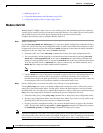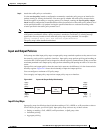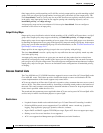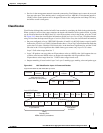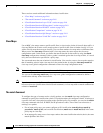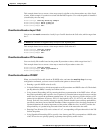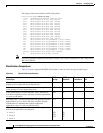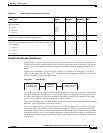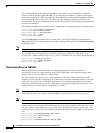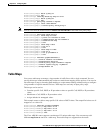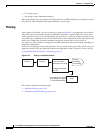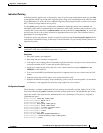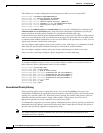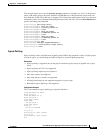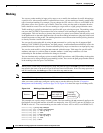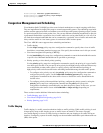
24-12
Cisco ASR 901 Series Aggregation Services Router Software Configuration Guide
OL-23826-09
Chapter 24 Configuring QoS
Understanding QoS
You can independently assign QoS-group numbers at the ingress to any combination of interfaces,
VLANs, traffic flows, and aggregated traffic. To assign QoS-group numbers, configure a QoS group
marking in an input policy map, along with any other marking or policing actions required in the input
policy map for the same service class. This allows the input marking and policing functions to be
decoupled from the egress classification function if necessary because only the QoS group must be used
for egress classification.
This example identifies specific packets as part of QoS group 1 for later processing in an output policy:
Router(config)# policy-map in-gold-policy
Router(config-pmap)# class in-class1
Router(config-pmap-c)# set qos-group 1
Router(config-cmap-c)# exit
Router(config-cmap)# exit
Use the set qos-group command only in an input policy. The assigned QoS group identification is
subsequently used in an output policy with no mark or change to the packet. Use the match qos-group
in the output policy.
Note You cannot configure match qos-group for an input policy map.
This example creates an output policy to match the QoS group created in the input policy map
in-gold-policy. Traffic internally tagged as qos-group 1 is identified and processed by the output policy.
Router(config)# class-map out-class1
Router(config-cmap)# match qos-group 1
Router(config-cmap)# exit
Classification Based on VLAN IDs
With classification based on VLAN IDs, you can apply QoS policies to frames carried on a
user-specified VLAN for a given interface. Per-VLAN classification is not required on access ports
because access ports carry traffic for a single VLAN.
The router supports two policy levels: a parent level and a child level. With the QoS parent-child
structure, you can reference a child policy in a parent policy to provide additional control of a specific
traffic type. For per-port, per-VLAN QoS, the parent-level class-default matches the VLAN; match
criteria is defined by the service instance encapsulation. You cannot configure multiple service classes
at the parent level to match different combinations of VLANs.
Note A per-port, per-VLAN parent-level class map supports only class class-default; it should be configured
with single rate policer. A flat policy can have multiple classes with match vlan and any action.
Note You can configure only class-default in the parent level of a per-port, per-VLAN hierarchical policy map.
In this example, the class maps in the child-level policy map specify matching criteria for voice, data,
and video traffic, and the child policy map sets the action for input policing each type of traffic. The
parent-level policy map specifies the VLANs to which the child policy maps are applied on the specified
port.
Router(config)# class-map match-any dscp-1 data
Router(config-cmap)# match ip dscp 1
Router(config-cmap)# exit
Router(config)# class-map match-any dscp-23 video



